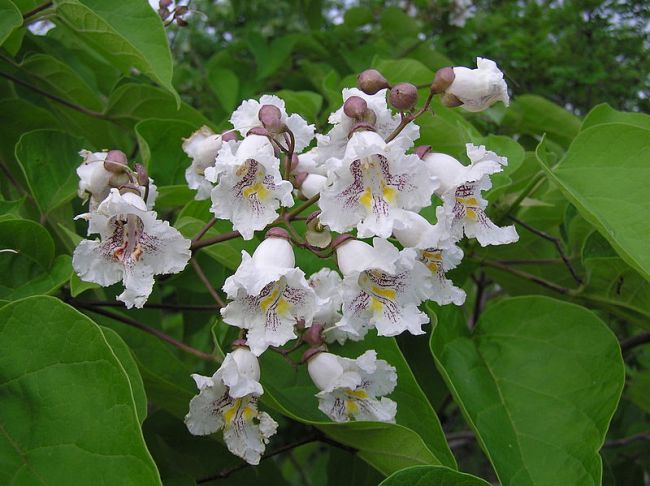
Catalpa bignonioides. Le.Loup.Gris. Wikimedia Commons.
There are many copycats in the plant world, between plant families in particular, but also those outside. Both Paulownia and Catalpa share a similar look, growth habit, and flower shape- which is why I decided to lump the two together in one post. Oh and their fragrances are nearly identical as well. They are in different plant families and come from different areas, but with similar ecoregions.
Lets start with Catalpas. Catalpa is native to the Eastern U.S. and Caribbean, with a few species in Asia as well. The trees grow up to sixty feet and have large, heart-shaped leaves, and large, foxglove-like flowers. The flowers are followed by long, cigar-shaped bean pods. The wood of the tree is soft and branches rather brittle. The tree makes a wonderful specimen planting for its showy nature, but the seed pods are difficult to clean up after winter.
The two American species are the most popularly planted. C. bignonioides is the Southern Catalpa, native to central Alabama, but planted largely throughout the Eastern U.S. C. speciosa, the Northern Catalpa, is native to the Mississippi and Ohio river confluence region, but is also widely grown throughout the Eastern U.S. The trees are identical, save for the Northern Catalpa is less floriferous, but has larger, and more fragrant flowers. Northern Catalpa is also slightly more hardy, but both are hardy to zone 5. The fragrance is described as being sweet-pea like, but I tend to think it more on a jasmine side. In either case, it is sweet, but a fragrance that does not lend itself to spreading through air. The trees bloom from May to June, maybe as early as April in zones 8-9, and as late as July in zone 5.

Paulownia tomentosa. Famartin. Wikimedia Commons.
Paulownia, or Princess tree, is a stately tree in a landscape, but is unfortunately invasive in the Southeastern U.S. One drive down Interstate 75 from London, Kentucky to Knoxville, Tennessee is enough to verify this. It is another Asian native, with cultural significance in China and Japan, where the Genus originates. Paulownia is nearly identical to Catalpa, but grows larger, and flowers earlier in spring, with purple flowers that are larger than Catalpa blooms. The winged seeds come in egg-shaped capsules born after flower dessication. The trees have this distinction of producing extremely large leaves when in its early-growth stages, or after the tree is cut back. In these years, the tree does not flower.
The flowers are a light lavender color, blooming in mid-to-late April and early May for two weeks (Catalpa blooms later in the season for much longer). The fragrance takes a cue from Catalpa, but throws in a strong vanilla fragrance to boot, and unlike Catalpa, generously fills the garden with its scent. The wood from Paulownia has a strong significance in Japanese art as well, and is one of more the more utilized woods for crates and chests, as it is very light and workable, much like Catalpa. Lastly, it does have agroforestry uses, but is best in its home range in China and Japan.
If one were to compare the use of the trees side-by-side, its best to air with Catalpa in the states, as its native to the region, and has more colorful flowers.
Well May has come to and end, and I’m sad about how many plants I didn’t get to this month but there is always the future right? Tomorrow will be a post about the wonderful month of June and what plants to expect then!

August 4, 2015 at 4:32 am
Thanks for that informative and interesting post. It exactly answers the question I had in mind.
I have two Catalpa bignonoides in my garden here in Lincolnshire, in North East England, and one is about to flower for the first time.
Having just bought a Paulownia, I was surprised by the apparent similarities in looks, habit and the response to heavy pruning.
Thanks, again, for a great article. Terry